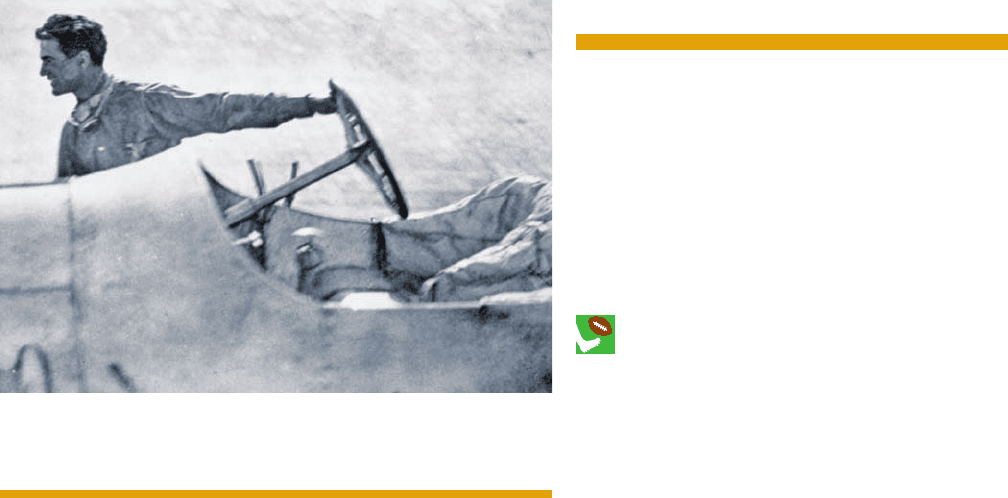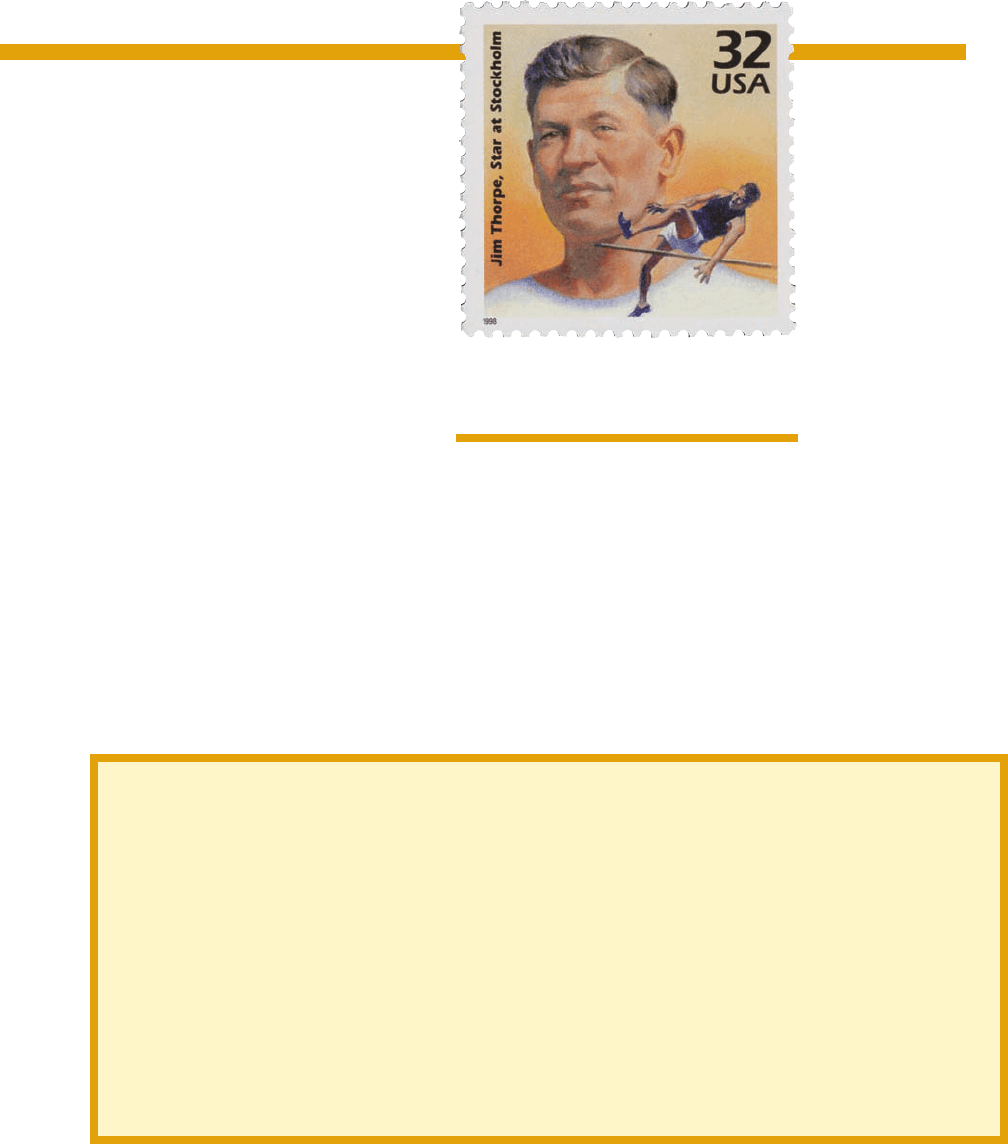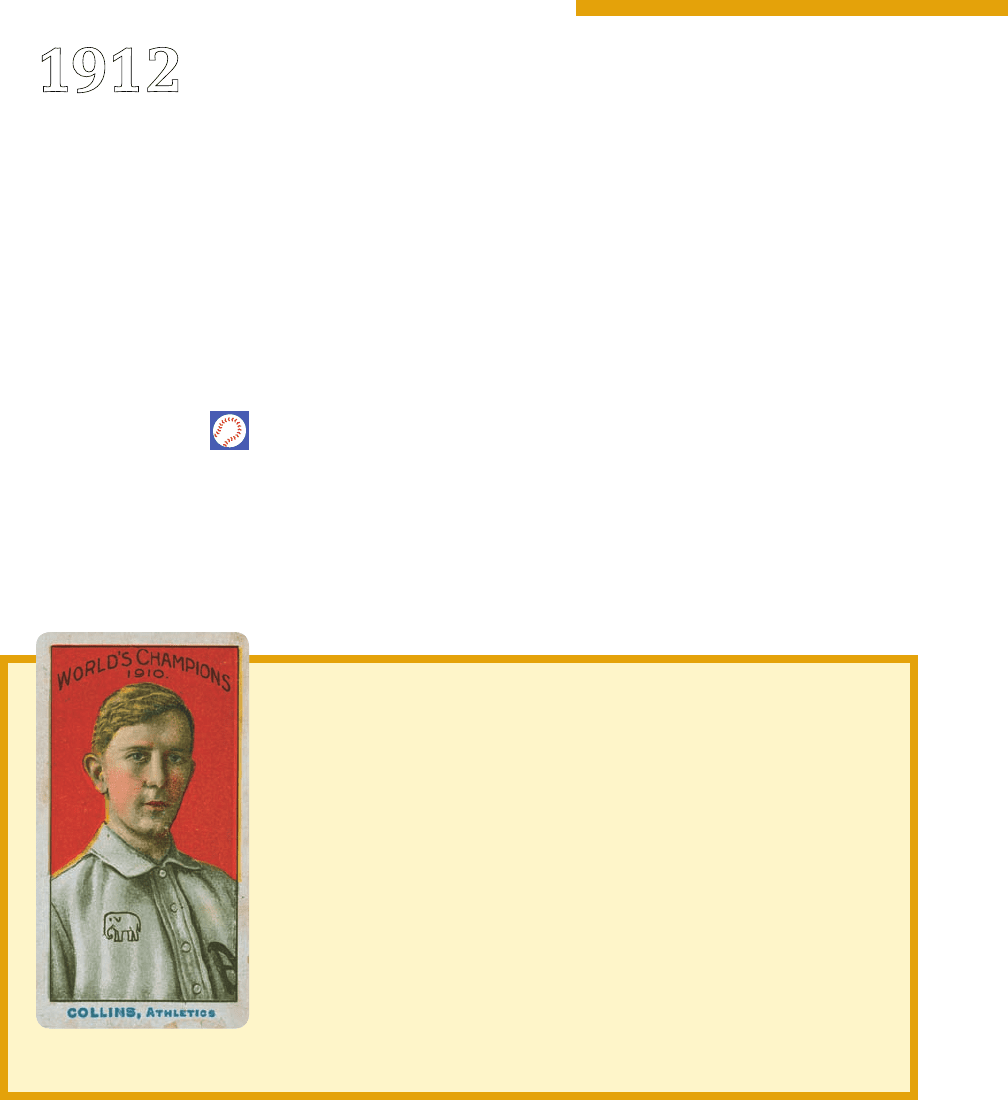Buckley James, Walters Jr. and John, Keith Larry. Sports in America: 1900-1919 (Sports in America: Decade by Decade)
Подождите немного. Документ загружается.


jump. Platt bettered his brother with
a leap of 5 feet, 4 inches.
• Ralph Craig sprinted to gold medals
in both the 100- and 200-meter races.
The 100-meter race had seven false
starts before Craig rallied in the clos-
ing strides of the eighth start.
• Americans finished 1–2–3 in the 800-
meter run as each man broke the
existing world record. James “Ted”
Meredith, a lightly regarded 19-year-
old, earned the gold in a race in which
the top five finishers were separated
by no more than four meters.
• In swimming, colorful Hawaiian Duke
Kahanamoku cruised to victory in the
100-meter freestyle. So convincing
was the Duke’s win that on the last
lap he turned around to see where
his nearest competitor was. Eye-
ing no threat, Kahanamoku coasted
home effortlessly.
In the Greco-Roman wrestling final
match, two light heavyweights, Sweden’s
Anders Ahlgren and Finland’s Ivar Boh-
ing, wrestled nine hours with neither man
giving in. Finally a draw was declared, and
the two were awarded silver medals.
Jim Thorpe’s Monster Year
Few athletes have ever accomplished
more than Jim Thorpe did in 1912.
As the dominant track and field athlete of
his era, the Sac-and-Fox Indian won two
gold medals at the Olympics in Stock-
holm, Sweden in July. And as the nation’s
most dominant college football player,
Thorpe scored 198 points and led tiny
Carlisle (Pennsylvania) Indian School to
a 12–1 record.
Thorpe’s first fabulous feat of 1912
occurred on May 25. Carlisle was compet-
ing against unbeaten Lafayette College
in a dual track meet. Legend has it that
Thorpe arrived at the meet accompanied
by one other schoolmate.
“You mean the two of you are the
whole team?” asked a Lafayette official.
“Nope,” Thorpe was said to have re-
plied. “Just me. The other fellow’s the stu-
dent manager.”
In truth, the 6-foot, 190-pound Thor-
pe was one of six members of the Carlisle
track team. Still, that day Thorpe won six
of the seven events he entered. Carlisle
easily won the meet, 71–41.
Two months later Thorpe was in
Stockholm for the Olympics. He was en-
tered in two of the most grueling track
and field events, the pentathlon and the
decathlon. The pentathlon combines five
events and the decathlon 10. Thorpe was
70
The Longest Mile Ralph DePalma completed 499 miles of the
Indianapolis 500 before his car gave out. DePalma got out and
pushed and pulled his car, but was disqualified from the race.

really competing in 15 events, then, in his
quest to win two gold medals.
He did. Easily.
In the pentathlon Thorpe won four
of the five events: the broad jump, discus
throw, 200-meter dash, and 1,500-meter
run. He placed third in the javelin throw.
The decathlon followed. Thorpe de-
feated all rivals in four events. He did well
enough in the other six events to win his
second gold medal of the Games.
The Swedish king, Gustav V, was
deeply impressed. “Sir,” the monarch told
Thorpe upon meeting him, “you are the
greatest athlete in the world.”
Thorpe was not yet done. On Novem-
ber 9, Thorpe and his Carlisle football
teammates met West Point with a 9–0–1
record. Still, Carlisle was considered an
underdog to the mighty Army squad.
Once again, though, Thorpe was dom-
inant. He scored two touchdowns (each
touchdown was five points), passed for
a third, and kicked three field goals and
three extra points in Carlisle’s 27–6 whup-
ping of Army. In other words, Thorpe had
a hand—or a foot—in every point his team
scored that day.
The afternoon’s most memorable se-
quence occurred when Thorpe fielded an
Army kick on his own 10-yard line and
returned it 90 yards for a touchdown.
The play was nullified by a penalty. Army
71
The reforms in college football begun in 1906 (see
page 41) continued throughout the years before
World War I.
In 1912, three important rules were instituted
that today’s fans will find familiar.
Fields were standardized as being 100 yards long,
with 10-yard deep end zones. Prior to this, fields were
larger or smaller depending on what a school had
available for space. Also, a touchdown’s worth was
increased from five points to six (an extra point was
worth one point). And a team was now given four
downs (instead of three) to advance the ball 10 yards
and make a first down.
These changes, plus the growing influence of the
forward pass, helped football get ready for a leap in
popularity with the coming of superstar running back
Red Grange and the birth of the National Football
League in 1920.
Sounds More Familiar
World’s Greatest Athlete Jim Thorpe
was honored with this U.S. postage stamp,
issued in 1984.

SPORTS IN AMERICA 1900–1919
kicked again. This time Thorpe fielded
the ball on his own five-yard line—and
returned it 95 yards for a touchdown.
Thorpe was a punishing running
back. One member of the Army defense
was so banged up from his fruitless ef-
forts to tackle Thorpe on this afternoon
that he never played football again. That
cadet was future five-star general and
the 34th President of the United States,
Dwight Eisenhower.
The Baseball Rematch
The 1912 World Series in October
was a rematch of an earlier Series
that had never been played. If that sounds
strange, consider this: It was also a best-
of-seven series that lasted eight games!
The Boston Red Sox and the New
York Giants were supposed to have met
in the second World Series in 1904. Giants
manager John McGraw thumbed his nose
at the upstart American League and its
representative, however, and declined to
play the Sox. The 1904 World Series was
never played (see page 32).
In 1912, the Giants were led by a pair
of future Hall of Fame pitchers—Christy
Mathewson and Rube Marquard. Boston
countered with 22-year-old star “Smokey”
Joe Wood, who had a 34–5 record.
Game Two of the Series finished in
a 6–6 tie at Fenway Park in Boston. The
Giants led 6–5 in the bottom of the 10th
inning when Red Sox center fielder Tris
Speaker circled the bases with an inside-
the-park home run, tying the score at six
apiece. After another scoreless inning,
the game was called due to darkness. The
game was declared a tie.
With the Series tied 3-3-1, the Giants
and Red Sox met in the decisive game 8.
New York took a 2–1 lead in the top of the
72
✔ On September 11, Philadelphia Athletics second baseman Eddie Collins stole
a Major League Baseball-record six bases against the Detroit Tigers. Eleven days
later Collins repeated the feat, swiping six bases against the St. Louis Browns.
✔ The Quebec Bulldogs won hockey’s Stanley Cup in March in the first sea-
son in which each team skated with six men on each team (previously, they
played seven to a side).
✔ Ty Cobb became the first Major Leaguer Baseball player to bat above .400
in consecutive seasons as he won his sixth consecutive batting title.
✔ Harvard went undefeated (9–0) in college football and was named national
champion.
Other Milestones of 1912
Eddie Collins

10th inning off Wood. A world champion-
ship was three outs away.
The bottom of the 10th was, for New
York, a tragedy of errors. Centerfielder
Fred Snodgrass dropped lead-off hitter
Clyde Engle’s routine fly pop-up. After
Snodgrass made a great catch on the next
batter, Speaker hit a lame foul pop fly
between the Giants first baseman and
catcher that neither player bothered to
catch. Given a second chance, Speaker
singled off Mathewson to bring in Engle
with the tying run. Two batters later, Red
Sox third baseman Larry Gardner hit the
game-winning—and Series winning—
sacrifice fly.
The 3–2 10th-inning win capped a
milestone season for Boston. The Red Sox
had moved into brand-new Fenway Park
(see page 68) and then won the final game
of the Series in it. And “Snodgrass’ Muff“
entered baseball legend.
The Horse, of Course
The growing use of automobiles in
racing mirrored their growing use in
everyday life. People who spent their lives
or their leisure time around horses wor-
ried that they might lose their fun if cars
erased horses forever. An article in The
New York Times on November 17, 1912
quoted the hopeful words of a key New
York, T. Suffern Tailer.
“As a matter of fact, the attitude of the
American people toward horses and their
use has changed radically in the last year.
. . . It is true that it seemed for a time as if
the horse were going to be ousted by the
automobile; but now in the horse’s return,
there is no real threat to the machine.
What is happening is that the motor car
is being recognized as the most comfort-
able and the most satisfactory means of
getting over the ground, and the horse
is finding its real place as furnishing the
most luxurious, the most beautiful, and
the smartest pleasure. . . When I speak of
the return of the horse, I don’t mean that
I think we are going back to the use of the
horse as we did before the invention of
motor cars. Of course not. But motor cars
have their place and horses have theirs.
. . . Horses will be kept for sport, beauty,
and luxury . . . for the enjoyment of life, for
its beauty and pleasure.”
73
Get Your Program! Note the unfamiliar spelling of the name of
baseball‘s championship on this scorecard from 1912.

1913
made it into the final rounds.) Two birdies
(one shot under par) on the second nine
holes salvaged Ouimet’s round, and put
him into a three-way playoff with Ray and
Vardon the following day.
By September 20, a Monday, news of
Ouimet’s upset bid had spread throughout
nearby Boston. Though there was a terri-
ble rainstorm throughout the final round,
the Brookline course was lined with new
fans of the sport—including friends of
neighbors of the caddy-turned-competi-
tor. Missing from the crowd, however, was
Ouimet’s father, who was dead-set against
his son’s golfing life.
Amid all this drama and downpour,
Ray and Vardon, the seasoned pros, wilted.
Ouimet and Lowery (who missed school
to caddy on this day) played and caddied
as if they had not a care in the world.
Vardon shot a 77 on the 18-hole play-
off. Ray shot a 78. Ouimet, meanwhile,
shot a 72. The boy next door had pulled
off the biggest upset in the history of golf,
and, in the process, given it mass appeal
on this side of the Atlantic.
Ouimet went on to a long life in ama-
teur golf, encouraging other young play-
ers and awarding scholarships to caddies
like Eddie.
Upset Special at the
U.S. Open
When the U.S. Open golf tournament
began in September at The Country
Club in Brookline, Massachusetts, most
observers expected the champion would
come from across the Atlantic Ocean.
Nobody thought the winner would liter-
ally be the boy next door. British golfers
Harry Vardon and Ted Ray, both profes-
sionals, were the sport’s elite, and it was
expected that one of them would win. Few
people were surprised when, after three
rounds, they were tied for the lead.
However, there was a third player, an
unknown amateur, also atop the leader
board. His name was Francis Ouimet.
He was 20 years old and he had grown
up across the street from the golf course
on which he was now playing. Ouimet,
in fact, had been a caddy on the course,
earning 28 cents a round. His knowledge
of the course would prove crucial in the
upcoming match.
During the fourth round of play, Oui-
met, accompanied by his 10-year-old
caddy, Eddie Lowery, fell behind early. (He
had grabbed Lowery, a young pal from
the neighborhood, when he surprisingly
74

The Big Train
If you were to name a Cy Young
Award winner for the decade—other
than Cy Young himself, who retired in
1911—it would undoubtedly be Walter
Johnson of the Washington Senators.
Johnson, also known as “The Big
Train,” won more games (264) and struck
out more batters (2,219) during the 1910s
than anyone else. Only in 1911 did the
long-armed, right-hander fail to lead the
American League in strikeouts. His best
year may have been 1913, though, when
he won 36 games and lost only seven.
It was a monster season by Johnson,
who led the majors in every notable pitch-
ing category. He was tops in wins, shutouts
(11), strikeouts (243), and complete games
(29), had the lowest ERA (1.09), and was
Fresh-Faced Kid American Francis Ouimet (center) was just 20 years old when he
stunned elite British golfers Harry Vardon (left) and Ted Ray (right) to win the U.S. Open.
75

SPORTS IN AMERICA 1900–1919
named the American League’s Most Valu-
able Player. His streak of 55 scoreless
innings that year stood as a big-league
record for 55 years, and no pitcher since
has won as many games in one season.
Thorpe Stripped of
His Medals
In the early part of the century, it
was not uncommon for a college
athlete to earn extra money by playing
semi-professional sports in the off sea-
son. It was against the rules, but not un-
common. Jim Thorpe, for example, spent
the summers of 1909 and 1910 playing
baseball for a team in North Carolina. He
earned $25 per week.
In January of 1913 a sportswriter
found a team photo of Thorpe’s North
Carolina, squad and recognized the
Olympic legend (see page 70). The story
spread like wildfire. The Amateur Athletic
Union (A.A.U.), which was responsible for
selecting athletes to represent the Unit-
ed States in the Olympics, demanded an
explanation.
“I never realized what a big mistake
I made by keeping a secret about my ball
playing and I am sorry I did so,” Thorpe
wrote in a letter to the A.A.U.
The A.A.U. took no pity on Thorpe.
The greatest athlete in the world was
stripped of his two gold medals from the
1912 Olympics. He immediately signed a
baseball contract with the New York Gi-
ants, but he was never the same person.
His medals were never returned to
him during his lifetime. Only in 1983,
30 years after Thorpe died destitute and
alone, did the International Olympic Com-
mittee return his medals to his family.
Notre Dame 35, Army 13
The forward pass had been legal in
college football since 1906. However,
most teams rarely used it. Notre Dame
University was one that did. The small
Catholic university had compiled a record
of 38–2–5 since 1907, but the powerhouse
teams—Yale, Harvard, Princeton and
Army—were still all in the East.
76
Big Train Washington’s Walter Johnson
had one of the greatest seasons by a
pitcher in big-league history
(see page 75).

On November 1, Notre Dame traveled
to West Point in New York State to play
mighty Army, which had won its first four
games by a combined 72–6 score.
Notre Dame had a secret weapon,
though. During the previous summer,
quarterback Gus Dorais and end Knute
Rockne had worked together as lifeguards
at Cedar Point, Ohio. The two pals had
worked on passing a football, which at
the time was a novelty. Rockne and Dorais
figured out how to calculate when a run-
ner would be at a certain position on the
field, so the quarterback could throw the
football to that spot and the receiver could
catch it without having to break his stride.
It was revolutionary.
When the game began, with 5,000
curious fans in attendance, Notre Dame
opened up its aerial attack immediately.
Dorais, the All-America quarterback, was
nearly perfect. Dorais completed 14 of 17
passes as the Irish stunned the Cadets
35–13. After Notre Dame’s rout of Army,
college football, and the Fighting Irish’s
humble place in it, would never be the
same.
A Real Champion Wrestler
Today, pro wrestling has more in
common with a three-ring circus
than with high-level athletics. Yes, the
wrestlers are great athletes—strong, fast,
and agile. But the “sport” they take part in
is not an open contest, but a pre-planned
spectacle.
Pro wrestling was not always so fake.
In fact, one of the biggest sports heroes
of this era was a pro wrestler. But in 1913,
Frank Gotch finally met his match. The
former Iowa farmer who had held the title
of Heavyweight Champion of the World
since 1908, was defeated by Georg Lurich
of Estonia in a match held in Kansas City,
Missouri.
Gotch wrestled in front of huge
crowds in places usually filled with base-
ball fans. His loss in 1913 didn’t diminish
his popularity, and he retired in 1915 as
the fans’ favorite.
77
✔ On March 10, the Quebec Bulldogs swept two games from
the Sydney Millionaires to win hockey’s Stanley Cup.
✔ On May 6 the Federal League, an alternative professional
baseball league with seven teams, quietly made its debut. It
would last for only two seasons.
✔ The longest long shot ever won the Kentucky Derby. On
May 10, Donerail, a 91-to-1 long shot, won the Kentucky
Derby, paying $184.90 for a $2 bet.
✔ On May 30, French driver Jules Goux won the Indy 500.
Goux took the checkered flag 13 minutes in front of runner-up
Spencer Wishart, which is still a record as the largest margin
of victory ever at the Indy 500.
✔ Former major league ballplayer-turned-evangelist Billy
Sunday attracted nearly 700,000 attendees to 94 services he
preached at this year. The aptly named preacher later tried to
outlaw Sunday baseball.
✔ On December 19, heavyweight boxing champion Jack
Johnson retained his title after fighting to a 10-round draw
against Jim Johnson in Paris, France.
Other Milestones
of 1913

1914
In 1914, though, the Federal League
decided to make a stronger push against
the A.L. and N.L. The “Fed’ expanded to
eight teams and into eastern U.S. cities
such as Baltimore and Buffalo. To make
matters worse, the “Feds” began tempting
Major League Baseball players to jump to
the new league.
On April 13—one day before Major
League Baseball’s opening day—the Fed-
eral League launched its season. The Bal-
timore Terrapins beat the Buffalo Feds
3–2 in front of 27,140 fans. The A.L. and
N.L. took notice.
Shortstop Joe Tinker and pitcher
Mordecai “Three Finger” Brown, both
future members of the National Baseball
Hall of Fame, soon signed with the upstart
league. Superstar pitcher Walter Johnson
nearly signed with the league, too, but at
the last moment the American League
chipped in to pay for The Big Train’s sal-
ary increase.
The Federal League, hounded by law-
suits from the other two leagues, soon
began losing money. Fans, their curios-
ity satisfied, returned to watching the
American and National League teams.
Two desperate Federal League franchises,
the Brooklyn Tip Tops and the Pittsburgh
A Major Alternative
The Federal League began play in
1913. It was a rare attempt to “chal-
lenge” the two Major Leagues. The Federal
League included six teams playing a six-
week schedule with no former big-league
players—except as managers. Cy Young,
for example, ran the Cleveland team.
78
A New Sponsor Federal League teams
sold beer at games and owners were not
against sponsors such as this company.

Filipinos, reduced ticket prices from 50
cents to a quarter.
Meanwhile, a few players did shine.
Indianapolis Hoosier Benny Kauff, a
rookie, led the league in batting with a
.370 average. Former Pittsburgh Pirates
pitcher Claude Hendrix went 29–11 for
the Chicago Whales. The Hoosiers, led by
Kauff and four other .300 hitters, won the
pennant by half a game over the Whales.
A year later the Federal League fold-
ed. In exchange for closing up shop and
releasing their players, Federal League
owners were paid $600,000—an enormous
sum in those days—by the American and
National Leagues. Meanwhile, the Ameri-
True Survivor Richard Williams (second from left; see page 82) poses with his 1914 Davis Cup teammates.
79
